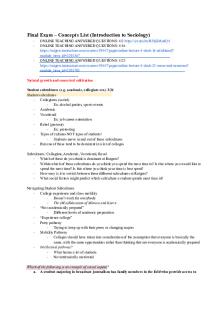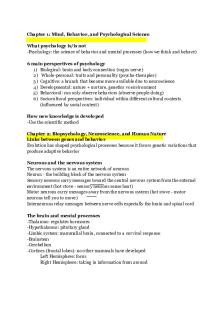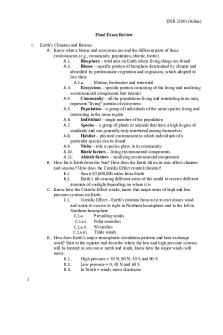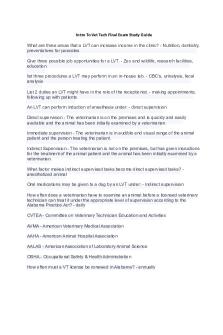Intro to Socio Final Exam Study Guide PDF

| Title | Intro to Socio Final Exam Study Guide |
|---|---|
| Author | Amy Choi |
| Course | Introduction to Sociology |
| Institution | Rutgers University |
| Pages | 17 |
| File Size | 418.7 KB |
| File Type | |
| Total Downloads | 54 |
| Total Views | 160 |
Summary
Study Guide of Final Concept List
Professor: Dr. Jeffrey Dowd...
Description
Final Exam – Concepts List (Introduction to Sociology) -
-
ONLINE TEACHING ANSWERED QUESTIONS: 4/2 https://youtu.be/R39jliMudQ4 ONLINE TEACHING ANSWERED QUESTIONS: 4/16 https://rutgers.instructure.com/courses/39447/pages/online-lecture-4-slash-16-adulthood? module_item_id=2291367 ONLINE TEACHING ANSWERED QUESTIONS: 4/23 https://rutgers.instructure.com/courses/39447/pages/online-lecture-4-slash-23-sense-and-nonsense? module_item_id=2301705
Natural growth and concerted cultivation Student subcultures (e.g. academic, collegiate etc.) 3/24 Student subcultures - Collegiates (social) - Ex: alcohol parties, sports events - Academic - Vocational - Ex: job career orientation - Rebel (protestr) - Ex: protesting - Types of cultures NOT types of students! - Students move in and out of these subcultures - But one of these tend to be dominant in a lot of colleges Subcultures: Collegiate, Academic, Vocational, Revel - Which of these do you think is dominant at Rutgers? - Within which of these subcultures do you think you spend the most time in? Is this where you would like to spend the most time? Is this where you think your time is best spent? - How easy is it to switch between these different subcultures at Rutgers? - What social factors might predict which subculture a student spends most time in? Navigating Student Subcultures - College experience and class mobility - Doesn’t work for everybody - The (Mis)Education of Monica and Karen - “Not academically prepared” - Different levels of academic preparation - “Experience college” - Party pathway - Trying to keep up with their peers or changing majors - Mobility Pathway - Colleges should have taken into consideration of the assumption that everyone is basically the same, with the same opportunities rather than thinking that not everyone is academically prepared - Intellectual pathway? - What harms a lot of students - Not intrinsically motivated Which of the following is an example of social capital? a. A student majoring in broadcast journalism has family members in the field who provide access to
information about potential jobs. b. A student had AP courses and multiple tutors in high school and therefore, can pass her courses with less effort than her classmates. c. A student consults websites that point to a coming shortage of nurses and teachers and decides to major in education. Which of the following is an example of cultural capital? a. A student had AP courses and multiple tutors in high school and therefore, can pass her courses with less effort than her classmates. b. A student majoring in broadcast journalism has family members in the field who provide access to information about potential jobs. c. A student consults websites that point to a coming shortage of nurses and teachers and decides to major in education. What do these two celebrities have to do with higher education? a. They created fake accomplishments for their children in order to get them accepted into top colleges. b. They got their children into top schools because they went to those schools and donated large sums of money to their respective colleges. c. They have both decided to enroll in PhD programs and become college professors. Party pathway/Vocational pathway 3/24 - READ THE ARTICLE ASSIGNED 3/24 Immigration and Assimilation Immigrants have historically been subject to prejudice and discrimination - There was a lot of animosity directed towards the immigrants - Presented to Congress by this guy named Madison Grant - Scientific Racism - There were these different European races that were categorized with inequality, some groups being genetically inferior compared to other groups - Splitting up the European races, serving as a political function, regardless of it not making logical sense - Demographics of the races have changed over the years for immigration - There has been a drastic increase of immigration to the US, however, it is only a small percentage of the population in the US - 22% of residents in NJ are foreign born, 3rd highest number of foreign born population in the US; India is the highest population of immigration in NJ Demographics of Mexican Immigration - 28% of all immigrants from Mexico (largest group) - 30 million people of Mexican origin live in the US - 13 million are immigrants Mexico - The border is a political boundary that people have created to designate these different political constituencies - Cultural boundaries and economies are more fluid
-
This sorting distorts our actual reality Purity and impurity
Idea of being split apart - Immigrant Population - 77% lawful immigrants - 23% unauthorized immigrants - 5% temporary lawful residents An individual choice that people made - Sets it up identifies the social structure by referring to laws but it seems to assume that there's a choice to break the law to come here legally or to come her illegally - Focuses on what these groups did not their different sets of opportunities, constraints, etc. - Ignored and seemed relevant, or assumed to be identical - What changed is how they’re being treated Immigration Narrative - In the past, immigrants, came to America, were often treated poorly, but they assimilated and became fully American - Idea of Pluralism: that you have two cultures and they get added together rather than one has to fade away - “Like immigrants in the past, today’s immigrants will do the same… and help strengthen our institutions.” - “Unlike immigrants in the past, today's immigrants want to change America… and they will weaken our institutions.” - BOTH of these arguments are wrong because the initial basis of them is wrong - Missing what immigrants actually did in the past: they wanted to change America and that they did strengthen our institutions - Immigrants in the past assimilated, while they believed that their cultures were still important Mexican assimilation - English language and American identity (usually by second generation) - Faster than Italian immigrants - Spanish fluency erodes slowly (36% of 4th generation can still speak Spanish) - Links to the previous generations What is assimilation? a. A minority group or a new group adopts the values and norms of the dominant culture. b. A minority group or a new group maintains its values and norms and adds to the dominant culture. Social trust Victim frame 3/31 Victim Nation - Our innocence, their treachery - Peace loving nation that accepts responsibility of world leadership and only uses military force to help others and protect freedom - Unprovoked attack - glorious victory - Exposed within a couple of years that that didn’t happen in the way that they made it seem i twas - Vietnam was a failure - War aims
-
Sustain America’s image of itself - Failure - Forces a reexamination of all Americans - The script was no longer accepted
Historical narratives 3/31 Ideals to Cynicism - “Vietnam still shapes America, even if most of us are too young to remember it.” - “What did the war do to us as Americans?” - Where did this decline in trust come from? National Identity - Peace loving nation that accepts responsibility of world leadership and only uses military force to help others and protect freedom - Script: out innocence, their treachery, leading to a glorious victory - Longstanding script - A national identity that develops in the 20th century Rewriting History - “We can and should help others to help themselves. But the fate of responsible men and women everywhere… rests in their own hands, not in ours.” - President Ford - The reason why there was a Vietnam war in the first place was because the United States was trying to determine Vietnam’s fate; it was trying to intervene to stop the popular will in Vietnam - Was from United States trying to intervene in someone else’s affairs Those who challenged the historical narrative of America, as a peace-loving nation that responded only to unprovoked attacks and then only to expand freedom… etc., questioned: a. Large parts of the American narrative and engaged in critical analysis of past events like America’s westward expansion b. Only America’s conduct during the Vietnam War and treated Vietnam as the exception to America’s foreign policy Breadwinner liberalism/conservatism 4/2 Breadwinner conservatism - Minimized women’s economic role - Valorized white male breadwinner - Stoked resentment to those who challenged white supremacy and patriarchy (government, people of color, counterculture) New Deal Consensus to Neoliberal Consensus Breadwinner Liberalism
Breadwinner Conservatism
Class hierarchy - unjust
Racial hierarchy - just
Racial Hierarchy - ?
Gender hierarchy - just
Gender hierarchy - ?
Class hierarchy - ?
Second-wave feminism (and backlash) 4/2 Second Wave Feminism - Happened in the 1970s - Some of the big outcomes are like Title IX - “No person in the United States shall, on the basis of sex, be excluded from participation in, be denied the benefits of, or be subjected to discrimination under any education program or activity receiving federal financial assistance. - ERA (Equal Rights Amendment) - Failed - Because there was a huge backlash of feminism in the 1970s - Gave rise of a countermovement - “Equality of rights under the law shall not be denied or abridged by the United States or by any State on account of sex.” Second-Wave Feminism (2 kinds of movements) Feminism
Anti-feminism
Challenge “traditional” gender roles
Gender roles as welcome
Question inequality
Inequality as simply differences
Differences as unequal and social
Differences as natural or ordained
Two of the biggest issues: - Abortion - Reproductive Rights Gender and the Natural Order - Social as natural - Sociology - These are social constructions - Those roles are not natural Social Construction of Gender - Gender socialization (culture) - Gender as an institution (structure) - Gender as a process (interaction, i.e. “doing gender”) Which of the following is a structural (i.e. gender as an institution) feature of society that feminists worked to change in the 1970s? a. Men would often open doors for women, women would wait for men to do this, as if women needed men’s assistance to open doors. b. Married women needed the signatures of their husbands to open bank accounts (even if they were employed and their husband were not). c. Women were taught in schools that they should aspire to be married homemakers rather than work outside the home.
Which of the following is a cultural (i.e. gender socialization) feature of society that feminist worked to change in the 1970s? a. Women were taught in schools that they should aspire to be married homemakers rather than work outside the home. b. Men would often open doors for women, women would wait for men to do this, as if women needed men’s assistance to open doors. c. Married women needed the signatures of their husbands to open bank accounts (even if they were employed and their husband were not). Which of the following looks at how we “do gender” (i.e. gender as a process) and was an example of how feminists thought people reproduced gender norms? a. Women were taught in schools that they should aspire to be married homemakers rather than work outside the home. b. Married women needed the signatures of their husbands to open bank accounts (even if they were employed and their husband were not). c. Men would often open doors for women, women would wait for men to do this, as if women needed men’s assistance to open doors. Abortion - Key battlegrounds of feminism and anti-feminism - Neither side would “win” - Battles continue today Social movements and countermovements - SEE FEMINIST MOVEMENT ABOVE!! Expressive individualism 4/9 Disco - Escape - Cultural dissent without direction - Multicultural individualism (expressive individualism) - No attempt to change or alter the society - Affluent hedonism “Disco Sucks” - Backlash - Gets associated with femininity - Homophobia, racism and sexism - White working-class identity - bundle of resentments The New Deal and the family wage 4/9 History and Cultural Choices - 1930s Economic Crisis - New Deal Consensus - 1970s New Deal Consensus falls apart - Many New deal programs remain (Social Security, Unemployment Insurance, Medicare, Medicaid, Pell Grants, Food Stamps, etc.) - Increase of deregulation, privatization, attacks on unions and social insurance programs… rising inequality and lower social mobility
New Deal Consensus (1930s-1970s) - Suburbanization - A government creation - A massive government program that subsidized loans after the Great Depression - Government cosigned all the loans (Federal Housing Authority) - Gave loans to racially homogenous neighborhoods (otherwise white neighborhoods) - Full employment - Trying to get unemployment as low as possible - Family Wage - Idea that the guy should get enough money to support the whole household - Does not exist anymore - Unions and social democratic policies - Protection from the market (Polanyi) - Where the market does not operate by supply and demand - Protect people from the vagaries from the market so their wages did not fall - No direct challenge to patriarchy or white supremacy - Limited the competition for good wages and jobs Deindustrialization Stagflation 4/9 - Inflation which is the cost of everything going up, at the same time that unemployment is rising - Wages weer stagnant and people were losing their jobs and inflation was happening - Happening because of the economic shots at the oil crisis Stagflation - Misery Index - The sum of the rate of unemployment and annual inflation, the index offers a gauge of stagflation. - Sense that the economic system is failing Busing (and anti-busing) 4/7 Boston, MA - Class and segregation - Gender and motherhood - “We’re looking out for the best interest for our children.” - Neighborhood schools - Forced busing - They’re being forced to do something - Resistance to integration/desegregation - Failure of busing? Desegregation Lifecourse 4/16 The lifecourse - Stages of human life are both biological and social
-
Childhood - Socially created stage of life course Tennager and Asolescence - In-between stage of being a child and an adult Young Adulthood - Period where you are not fully independent from one’s parents - Understand that there will be some level of dependency
Adulthood/Rising Debt 4/16 Models of Adulthood - 1950s-1960s: new definition of adulthood in US - Independence from extended family - nuclear family (single unit) - Result of institutional changes: - Low interest mortgages, GL Bill, Social Security, unemployment insurance, family wage, etc. - Allowed for nuclear family to be independent, not depending on others - Replaces some of the family dependency to state dependency What people think is important to being considered an adult - Complete education (97%) - Financial independence (97%) - Work full-time (96%) - Able to support a family (94%) - Leaving parents’ home (82%) Expectations did not radically change - Expectations: % of adults saying children should have to be financially independent from their parents by age 22 or younger (64%) - Reality: % of young adults who are financially independent from the parents by age 22 or younger (24%) Delayed Adulthood - ¼ of child care costs after age 17 - ⅔ of adults in their early 20s - 40% in their late 20 receive financial assistance from their parents - Why? Cultural Reactions - Defined as personal troubles - Debt, lack of career, financial insecurity and dependence depicted as moral failing - Lack of initiative, work ethic, responsibility - “Adultolescents” - slackers who refuse to grow up - Sense of entitlement, lack of long range goals, and lack of persistence - Depicted as children who let their parents down - Ignore all the institutional changes - May have predicted that this may have happened, radically changing the social circumstances Which features of society would make young people less dependent on family wealth? a. Low interest mortgages, free college, social security, unemployment insurance b. Rising house costs, tuition hikes, less retirement security for parents Which features of society would make young people more dependent on family wealth?
a. Low interest mortgages, free college, social security, unemployment insurance b. Rising house costs, tuition hikes, less retirement security for parents A different set of opportunities and constraints exists for people born during different time periods. These social factors condition dependency of family wealth. Mills asks us a. To consider the intersection between history and biography when seeking to understand outcomes for groups of individuals b. To avoid engaging in confirmation bias when looking at generational and historical trends c. To consider the role of economic capital in shaping the opportunities of all people Science and Pseudoscience 4/23 IQ and social patterns/forces 4/23 “I didn’t say that…” - Charles Murray - IQ is all about genetic difference between blacks and whites - Social outcomes are entirely genetic - Book is all about race - Eugenics is good - Weed out bad genetic inferior people - Encourage the people with high genetic people What he does say - IQ measures intelligence and matches what we commonly think of as “smart” - IQ scores vary, on average, by race - IQ scores correlate with socio-economic outcomes and parents scores - Therefore, IQ is genetic, and genetic differences partly explain unequal socio-economic outcomes for blacks and whites - Not falsifiable, lacks consideration of other hypotheses Evidence - IQ differs, inheritable, correlates with socio-economic outcomes - The point he is making: IQ is genetic, differences cannot be fully explained by the environment - Not sufficient Falsifiability, Alternative Hypotheses 4/23 Social claims and falsifiability - “If the reader is now convinced that either the genetic or environmental explanation has won out to the exclusion of the other, we have not done a sufficiently good job of presenting one side or the other. It seems highly likely to use that both genes and the environment have something to do with racial differences.” - The Bell Curve - Being partly this or partly that is not a falsifiable statement - Ignores it by not considering another hypothesis Alternative Hypotheses - Extreme Environmentalism: Blacks are genetically on a par with whites, so the IQ gap is all environmental. - Extreme Geneticism: Blacks are environmentally on a par with whites, so the IQ gap is all genetic - The Reasonable View: Blacks are worse off both genetically and environmentally: some of the gap is genetic, some environmental - Alternative: Blacks are genetically superior and environmentally disadvantaged
Which of the following is a falsifiable claim? a. Americans are more likely to rate music that was popular when they were teenagers as better than music that comes out when they are older. b. We shouldn't try to rate music, since all musical preferences are just a matter of taste. c. The music of the 1960s was the best music in American history. If someone says that a shortage of toilet paper was caused by individuals engaged in hoarding, which of the following would help to make that claim scientific? a. Examine other possible causes, like disruptions in supply chains b. Find a bunch of examples of people who hoarded toilet paper c. Assume that disruptions must be due to hoarding because they can’t think of another explanation Social scientists engage with previous research because? a. Previous research can point scientists to new research questions and ensure they consider alternative hypotheses. b. Once something is established as research it is settled science and should not be challenged. Vulnerability 4/28 Sociology and Crisis (Concepts are tools that we use to avoid crisis) - Vulnerability - Shifts our focus off those things - Ex: smoking - Having smoked cigarettes in the past are one of the most common factors to why people die Vulnerability - Why don’t they just…? - Individualizing - Way of indi...
Similar Free PDFs

Intro to Biology Exam 2 study guide
- 11 Pages

Intro to Stats Final Study Guide
- 15 Pages

Intro To Psych Final Exam
- 24 Pages

Final Exam study guide
- 40 Pages

Final Exam Study guide
- 2 Pages

Final Exam Study Guide
- 105 Pages
Popular Institutions
- Tinajero National High School - Annex
- Politeknik Caltex Riau
- Yokohama City University
- SGT University
- University of Al-Qadisiyah
- Divine Word College of Vigan
- Techniek College Rotterdam
- Universidade de Santiago
- Universiti Teknologi MARA Cawangan Johor Kampus Pasir Gudang
- Poltekkes Kemenkes Yogyakarta
- Baguio City National High School
- Colegio san marcos
- preparatoria uno
- Centro de Bachillerato Tecnológico Industrial y de Servicios No. 107
- Dalian Maritime University
- Quang Trung Secondary School
- Colegio Tecnológico en Informática
- Corporación Regional de Educación Superior
- Grupo CEDVA
- Dar Al Uloom University
- Centro de Estudios Preuniversitarios de la Universidad Nacional de Ingeniería
- 上智大学
- Aakash International School, Nuna Majara
- San Felipe Neri Catholic School
- Kang Chiao International School - New Taipei City
- Misamis Occidental National High School
- Institución Educativa Escuela Normal Juan Ladrilleros
- Kolehiyo ng Pantukan
- Batanes State College
- Instituto Continental
- Sekolah Menengah Kejuruan Kesehatan Kaltara (Tarakan)
- Colegio de La Inmaculada Concepcion - Cebu









